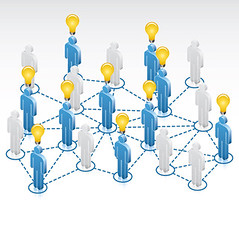
Understanding customer innovation
In his blog “The Design of Opportunity: Defining Customer Innovation”, Chris Lawer, Managing Director of Strategyn UK & CEO-Founder of ZinC, explains that customer innovation incorporates several different concepts that help to address the changing needs of the social consumer. Fundamentally, the emphasis is on creating a process that continuously incorporates customer insight into product and service development, while it fosters enterprise wide collaboration. Empowered by technology, today’s social customer is a collaborator, with employees and business partners, on more than the creation of new products. Customers are also actively involved in developing new approaches to business processes, increasing capability and fostering continuous learning.
Customer innovation: Organizational implications
According to Chris Lawer, in addition to having a significant impact on all aspects of the product and service management strategy, customer innovation also has important implications for:
• Brand strategy and management
• Customer experience design and delivery
• Customer relationship management
• Customer service design and quality management
• Knowledge management, including market research
• Partner and customer collaboration
• Organizational goal alignment with customer expectations
• Innovation valuation, measurement and prioritization
OneDesk helps facilitate customer innovation
With OneDesk, you can address product and service management needs and help foster customer innovation by letting all stakeholders, customers, business partners and employees, share their insights. You can then take immediate action by linking this feedback to requirements and project management applications. Getting critical and essential market input related to your products or services, quickly, does not have to be a difficult or cumbersome process.
More specifically, OneDesk has several advantages in developing customer innovation, because these powerful tools help you:
• Find out what your customers want. You can discover the needs of the marketplace and then prioritize R&D efforts based on actionable metrics.
• Move across the phases of development quickly—from implementation to launch you can reduce time-to-market.
• Structure the work-related conversation by getting all stakeholders on the same page to get work done efficiently.
• Promote enterprise-wide collaboration to increase learning and innovation.
• Leverage your customer insight so that you can discover and tap into new untouched markets and stay on top of industry trends.
• Take the guesswork out of the product and service development process by effectively managing and forecasting revenues and costs.
Through effective customer feedback, requirements and task management, facilitates customer innovation by effectively capturing and integrating customer insight into the product and service development process. The result is the creation and delivery of customer-centric products and services that exceed marketplace expectations.
How does your organization plan to incorporate customer innovation into your corporate strategic road map over the next few years?
Related blog posts:
Open innovation: Structuring businesses
Innovation in the workplace
Innovative ideas: Important!
Innovation As A Service: A new concept
Innovative Products: Rewarding
Disruptive innovation: Avoiding it
Collective intelligence: Innovation 2.0
Innovation and creativity work together
Collaborative Innovation: A Use Case